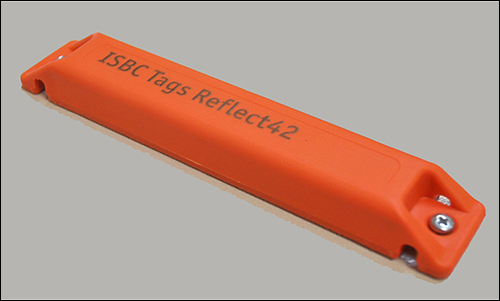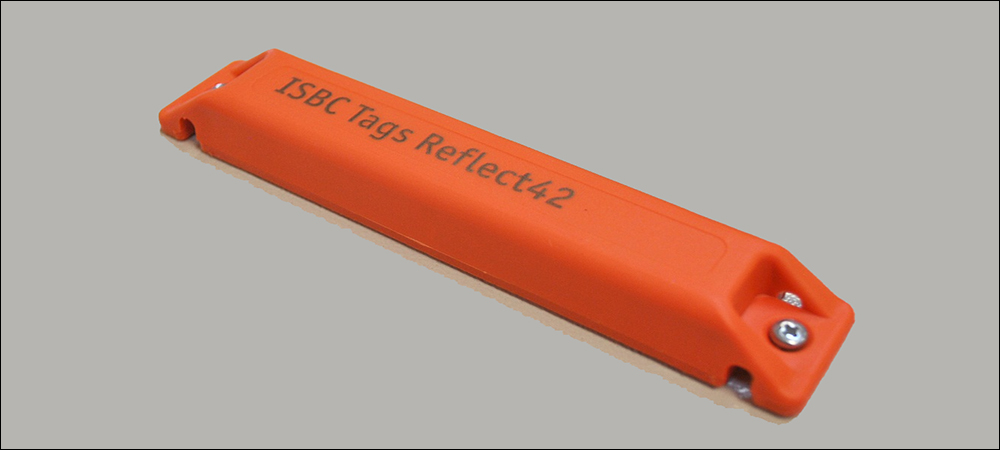Passive UHF RFID tags are being adopted in some challenging environments, for such uses as train and vehicle tracking, mining operations and manufacturing. But an RFID system can often be compromised by the high presence of metal, which can interfere with transmissions, as well as dirt, chemicals and ice. In fact, applications such as tracking heavy machinery in industrial environments can be highly challenging for wireless technology. With that in mind, ISBC Group has released a hard tag designed for long transmission on metal, at low power, that it says will make RFID systems more stable and reliable with a longer range.
The tag is engineered with an antenna design that can leverage the metal surface to which it is attached, in order to help extend its transmission range. According to the company, the passive UHF RFID tag, known as the Reflect42, can transmit data up to a distance of 42 meters (138 feet), whether it is stationary or moving, and also performs better in the presence of frost.

ISBC Group’s Reflect42 tag
The result, the company says, is a tag designed to work well in all conditions, from summer to winter. ISBC’s engineers designed the tag throughout the past several years for use in challenging environments containing a high level of metal, where tags may be exposed to chemicals, dirt and ice, and where readers cannot always be positioned in close range. The tag is already in use for rail, mining and truck fleet management in Russia and in Eastern Europe’s Commonwealth of Independent States countries, says Andrey Krasovskiy, the director of ISBC’s RFID Department. Now the company is commercially releasing the tag, which is the first in what is expected to be a family of at least five products.
The UHF 865-868 MHz frequency enables the tag’s use throughout Europe, while the company says it has adapted the technology to meet North American UHF frequency requirements as well. Moscow Metro, for instance, is using the tag to help identify its inventory of rail cars. A tag attached to the side of a car can be interrogated by a fixed reader mounted or installed near the tracks, even while rail cars are in motion.
Another use case is in mining. The Reflect42 tags are currently in use by a mining company that has asked to remain unnamed. The company has attached the tags to trolleys so that they can be identified via a fixed or handheld reader located above or below ground, without requiring personnel to manually search for a trolley’s visual ID number in order to identify it. Similarly, 16-ton trucks at a mining site are being tracked via attached Reflect42 tags that transmit each vehicle’s unique ID.
In addition, the tag is being employed on fuel tank trucks to capture the ID of each vehicle carrying oil and gasoline at fueling stations and other sites, thereby helping to provide automated data regarding each vehicle’s location and status. At weight scales, the tags can transmit data as each vehicle is being weighed.
The tag comes with a vandal-proof enclosure built to be chemical-resistant to oils, acids, alkaline solutions and solvents. It comes with a built-in NXP UCODE 8 chip. ISBC has tested the tag with FEIG Electronic‘s UHF LRU1002EU plus long-range reader with a 9 dBi antenna. Other off-the-shelf RFID readers will also work well with the tag, Krasovskiy notes.
“This tag was created for complicated use cases,” Krasovskiy says, and it works well for both long- or middle-range transmissions. “[In] middle-range applications,” he states, “you can reduce the energy of the RFID field” to shorten the read range. For instance, by reducing the ERP power from 1.5 watts to 0.5 watt, a user can cause the tag to respond only to readers interrogating from a medium distance of about 20 meters (66 feet) or less. That can reduce the risk of stray reads if there are multiple tags and readers within the area. Companies deploying RFID applications can benefit from designing systems at low power, he says, adding, “And you can reduce the influence of electromagnetic waves to humans. Our customers like this opportunity very much.”
The long read range is accomplished with the tuning functionality of the UCODE 8 chip, as well as some engineering of the antenna that leverages the metal surface to extend its range. “We test every manufactured tag,” Krasovskiy says, through a quality-control service. Because frost may further extend the read range, the company reports, the tag is suitable for use in northern regions.
That performance results from engineering that takes advantage of the tendency of metal surfaces and antennas to shrink at low temperatures. The material in the tag helps the antenna gain better sensitivity and directivity, the company explains. The polypropylene case around the tag is made with ISBC’s thermoplastic machines, Krasovskiy says, providing the tag with an IP68 rating for dust and moisture. “This product was tested in climatic chambers and [with] vibroshock equipment,” he states.
The tag measures 136 millimeters in length by 25.5 millimeters in width by 14.5 millimeters in height (5.4 inches by 1 inch by 0.6 inch). It can be attached via screws, plastic clamps, magnets on metal, or glue, and can operate within a temperature range of -35 degrees to +70 degrees Celsius (-131 degrees to +158 degrees Fahrenheit). The company intends to make more tags under the ISBC Tags brand name this year, for a total of five types in varying sizes, some of which will be considerably smaller than the Reflect42. Two other new tag models are ready for production, the firm reports, with sales expected to start in mid-June. The tags, each designed to operate on metal, can be interrogated from a distance of either 16 meters or 25 meters (52 feet or 82 feet).


